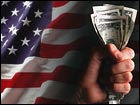|
Confidence, durables orders up
|
 |
January 29, 2002: 10:48 a.m. ET
Unexpected gains in economic data point to Fed standing pat on rates.
|
NEW YORK (CNN/Money) - The confidence of U.S. consumers rose for the second straight month, a private research group said Tuesday, while the government said factory orders for long-lasting goods jumped in December.
Together, the data are signs of an imminent economic recovery and reinforce the consensus view that the Federal Reserve will leave interest rates alone at its latest policy meeting, which begins Tuesday afternoon.
The Conference Board, a private research group, said its index of consumer confidence rose to 97.3 in January from 94.6 in December, the second straight month of gains. Economists surveyed by Briefing.com expected confidence to rise to 96.0.
"While the economy has not turned around yet, the worst may well be over," said Lynn Franco, director of the Conference Board's Consumer Research Center. "The upturn in confidence is being driven by growing confidence about the business outlook and job prospects. Consumer expectations for the future are now higher than they have been in more than a year."
Separately, the Commerce Department said orders for durable goods such as cars and computers rose 2.0 percent in December after falling a revised 6.0 percent in November. Economists surveyed by Briefing.com had forecast that durable goods orders would rise 1.3 percent.
Wall Street yawned at the reports, choosing instead to wait for the Fed's decision on rates, due Wednesday. Stock prices were mixed, while Treasury bond prices were mostly lower.
The Conference Board's expectations index, measuring how consumers think the economy will do six months from now, rose to 96.9 from 92.4. The present situation index, measuring how they feel about the economy right now, was unchanged at 97.8.
Consumer spending fuels two-thirds of the U.S. economy, and the Federal Reserve cut short-term interest rates 11 times in 2001 to make borrowing easier and keep consumers spending. They were battling the effects of a recession that some economists think began in March, the Sept. 11 terror attacks and more than a million job cuts.
But most economists think the central bank, encouraged by signs of stabilization in consumer sentiment and manufacturing, will probably hold interest rates steady.
"We have seen a change in the texture of the economic data. A month ago, the reports were not clear-cut, as some were good [and] some were weak," said Joel Naroff, president and chief economist of Naroff Economic Advisors. "Recently, the pattern has been for a surprise in the numbers on the upside. The [Fed] is seeing the same trend in the data, and it would be a shock if they did anything but stand pat."
Excluding volatile defense items, durable-goods orders rose 1.7 percent after rising a revised 1.5 percent in November. Excluding transportation goods, orders rose 1.4 percent after falling 1.1 percent in November.
Among the categories gaining in December, orders for computers and electronics rose 3.5 percent, semiconductors rose 13.3 percent and defense capital goods orders rose 10.8 percent.
The manufacturing sector has been in recession for 17 months, the hangover from a capital-spending boom in the late 1990s that led to excess production and a glut of unsold goods when the boom went bust.
Despite December's gain, the second in three months, orders for durable goods for the entire year fell 12.8 percent on a seasonally adjusted basis from 2000, the only such decline since 1992, the earliest year for which comparable data are available.
But the Commerce Department also said inventories fell for the 11th straight month, dropping 0.4 percent to $284.7 billion. Once inventories are reduced, companies can start to increase spending and production again.
CNN/Money's economic calendar
And Tuesday's data follow a report earlier this month from the Institute for Supply Management, formerly known as the National Association for Purchasing Management, showing the sector may have finally hit bottom.
"There's bound to be a recovery in [capital spending] sometime soon. We have had basically no capital investment for about year," Bruce Bartlett, economist at the National Center for Policy Analysis, told CNNfn's Before Hours program. "At some point, machinery wears out, and you've got to replace it." 
|
|
|
|
|
|

|

